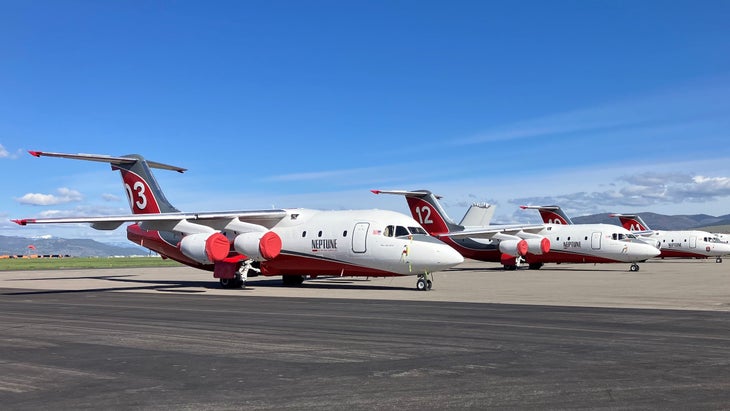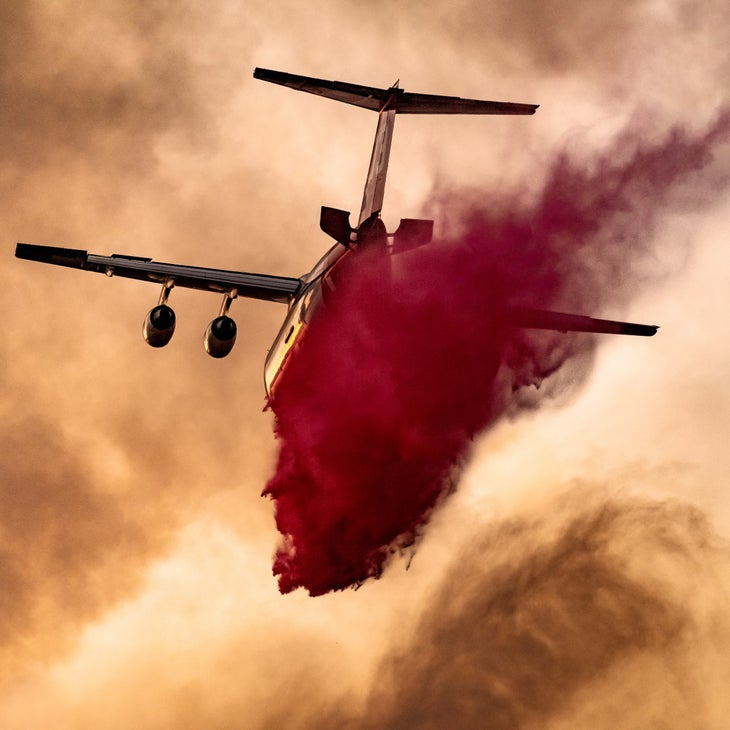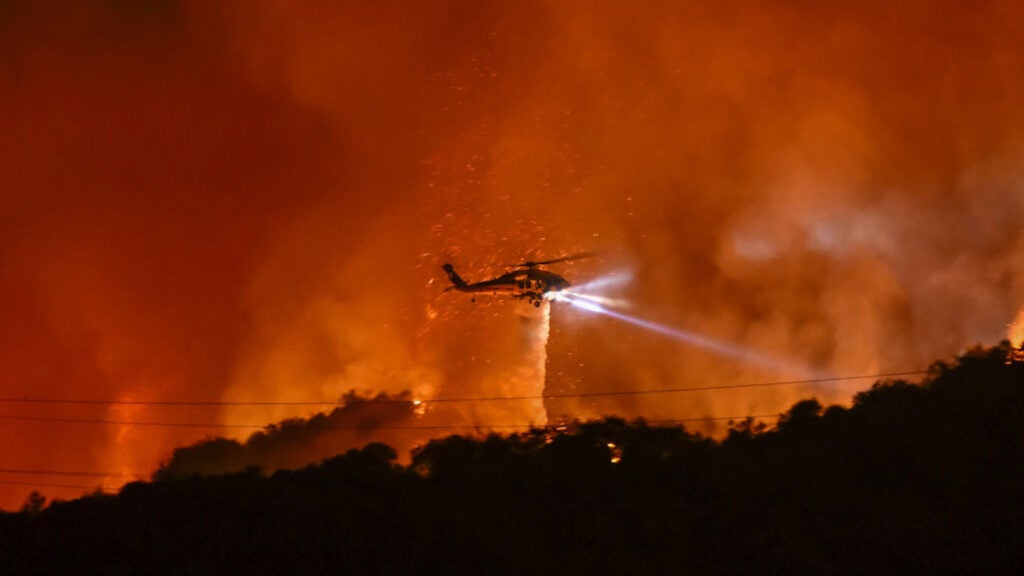Outdoor Adventure
What It’s Like to Be an Aerial Tanker Pilot During the L.A. Fires
On Tuesday, January 7, 2025, the azure sky and gleaming sun that are hallmarks of Los Angeles, California, were rapidly replaced by thick grey smoke swelling upwards from fast-moving fire within Pacific Palisades. Hours later, another blaze, called the Eaton Fire, began to consume huge swaths of Pasadena and Altadena.
Since then, the skies of Southern California have been crisscrossed by a dizzying number of firefighting aircraft: helicopters, propeller-driven water bombers, and even massive tanker jets. You may have seen videos of these airplanes and helicopters on social media, dropping orange slurry near homes or spraying buckets of ocean water on rising flames.
Aerial firefighters—the pilots, flight coordinators, and crew—have played a vital role in the battle against the worst fire season in Southern California history. As of publishing, the Palisades and Eaton fires have burned for six days—with a handful of smaller fires, like the Kenneth Fire and Hurst Fire breaking out as well. In total, these blazes have consumed 40,000 acres of land and 12,300 structures. The death toll of the fires, overall, has risen to 24.
Outside spoke to aerial firefighters to understand how they have contributed to the lifesaving efforts across Southern California, and to understand why the blazes present such a challenge for crews both on the ground and in the skies.
“The Palisades and Eaton fires are in the top three worst fires I’ve worked in my 30-year career,” says fire captain and helicopter coordinator John Williamson with Cal Fire, the fire department of the California Department of Forestry and Fire Protection.
The Importance of Aerial Firefighters
Aerial firefighters have the same job as ground-based firefighters, but aerial firefighters corral the flames the sky. They work in tandem with ground crews to support their efforts by dropping thousands of gallons of fire retardant and water to critical fire areas with each fly by.
“There is no longer a fire season. It is now a fire year.”
It’s a dangerous job. Since 2020, there have been 14 fatal aerial firefighting aircraft crashes resulting in the deaths of 25 aerial firefighting crew members in the U.S. In contrast, not a single U.S. commercial passenger airline pilot has been killed in a flight crash since 2020.

There are more than 50 aerial firefighting aircraft assigned to the Los Angeles fires that come from several agencies. Some aircraft are from Cal Fire Aviation, the largest civil aerial firefighting fleet in the world with 60 rotary and fixed-wing aircraft. Others are from private companies like Montana-based Neptune Aviation. And others still have flown in from other fire departments across North America, including a crew from Quebec, Canada.
Aerial firefighting fleets vary in size. Cal Fire retains the likes of multiple 1,200-gallon-capable Grumman S-2T airtankers, 4,000-gallon-capable C-130 Hercules airtankers, Bell UH-1H Super Huey helicopters, Sikorsky S-70i helicopters, and North American OV-10A Bronco Air Tactical Aircraft. Neptune Aviation owns nine BAe 146 airtankers, each of which can hold 3,000 gallons of fire retardant and four of which are currently assisting with the Los Angeles fires.

No matter the aircraft, Williamson, who’s currently in Los Angeles working the Palisades and Eaton fires, notes that aerial firefighters’ jobs are entirely to support the first responders on the ground.
In previous years, wintertime has been a quiet season for aerial firefighters, with most on vacation and many of the fleets put away for maintenance. But this is changing, due in part to a shift in climate and drier conditions yearround. Now, agencies like Cal Fire must be ready to battle wildfire at any moment.
“There is no longer a ‘fire season,’” says a spokesperson from Cal Fire. “It is now a ‘fire year.’”
The Santa Ana Winds
The nearly 100-mile-per-hour winds made the first evening of firefighting a biblical “man vs. wild” battle. The fires initially had to be fought almost entirely by groundcrews as the hurricane-force gusts made aerial firefighting unsafe and ineffective. These winds, known as the Santa Ana, are seasonal, strong winds that blow south into the Los Angeles area from the Mojave Desert. The Santa Ana Winds are known for fanning wildfire flames and causing a vertical wind shear, which can make flying dangerous or impossible.
“These fires are significant because of the wind event that preceded them,” says Williamson. “The high winds spread the fires quickly and made it difficult for any aerial firefighting to occur in the initial hours…I hate to describe it this way, but everything leading up to these fires created the perfect storm.”
“We see the devastation from a different perspective.”
As the wind speeds decreased slightly on January 8, aerial firefighters took to the sky and began dropping thousands of gallons of fire retardant and water across the Palisades and Eaton fires.
But the wind has continued to create headaches. Williamson says that crews must assess wind gusts each day to make sure that it’s safe to fly—and to ensure that their drops of slurry or water are accurate.
“Additionally, the infrastructure here in Los Angeles presents a challenge with so many above-ground electrical wires and tall structures,” Williamson says. “Not every aerial firefighter assigned to these fires is from Los Angeles, so some are learning the terrain as they go.”
Aerial Firefighting Logistics
At the beginning of each day, aerial firefighters receive a morning briefing at their assigned air base before linking up with officials who coordinate helicopter flights or air attack routes. These specialists are like aerial firefighting air traffic control: they tell aerial firefighters where to fly and at what elevation in the firefighting airspace to best support ground crews.
The size and intensity of the Los Angeles fires means that the “stack,” or elevation layers of an airspace, in which the aerial firefighters fly is crowded and limited.
“The wind and the amount of aerial firefighters we have working on these fires has made the stacks complicated,” Williamson says. “We currently have a thousand feet of elevation between each aircraft in a stack to give our crews some buffer, and we’ve been having to closely monitor where and how each aircraft in a stack goes about their jobs due to the high winds and terrain of these fires.”
For reference, commercial airplanes are allowed to have 1,000 feet of stack between them when flying below 29,000 feet, and must have 2,000 feet of stack between them when above 29,000 feet.
Neptune Aviation’s Chief Pilot Eric Komberec says the Palisades and Eaton fires have been some of the most challenging to fight from the air.
“The urban interface and airspace concerns with so many other commercial airports in the [Los Angeles] area combined with the low moisture index and intense winds has made this a complicated fire for our aerial firefighters to tackle,” Komberec says. “There also aren’t any firebreaks due to the urban environment, so we have few ways to corral these fires. We have to attack them totally differently than we would a true wildland fire.”
Komberec notes that crews are accountable for their drops of fire retardant—which are determined by the pilot only through mental math and “eyeballing it.”
The crosswinds, he says, have made it difficult to maneuver planes and ensure an accurate drop of retardant. “We are held accountable for every drop of retardant we make,” Komberec says. “It’s not only extremely expensive, but can be dangerous when dropped on or near congested areas. Given the urban interface of this fire, we have to be extremely concerned with making sure we’re at the appropriate height and angle for a drop.”
The Mental Toll
A week of round-the-clock work has taken its toll on the aerial firefighting crews in Los Angeles.
Williamson says pilots have very little downtime in between shifts, with almost every waking moment devoted to gearing up for the next one. “After a shift you’ll eat and rest and let your mind unravel a bit from what you just went through,” he says. “But even when you’re not on a shift, you’re strategizing with other crew members, trying to make your plan for the next shift to hopefully be even more effective than during the last one.”
Crews must also manage the psychological impact of viewing the destroyed neighborhoods and city centers from the air.
“We see the devastation from a different perspective,” Williamson says. “The images of destruction are seared into your brain. It’s hard to see how far the burn scar extends knowing the loss of property and life that came with it. You can’t dwell on these things while working, though. You have to keep grinding until the job is done.”
Source link

